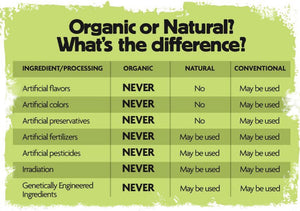The differences between organic and conventional foods stem directly from the farming methods that were used during the food’s production. Many people are unaware of some of the differences between the two practices. Agriculture has a direct effect on our environment, so understanding what goes into our agriculture is important. Below is a list of some of the key differences between organic and conventional farming.
One of the biggest differences that is seen time and time again across all research between the two farming practices is the effect on the land. Organic farming works to increase sustainability, biodiversity, and to encourage good soil and air quality. This is maintained by the use of natural growing practices, the avoidance of harmful chemicals, and the continued practice of crop rotation and other natural farming methods.
Organic Farming
- Organic farming promotes biodiversity
- Soil health is improved with organic farming practices
- Only natural methods are used in organic farming
Conventional Farming
- Conventional farming makes use of chemicals, synthetics, and other materials to manage weeds and pests
- Conventional farming uses unnatural farming methods
- Conventional farming use of pesticides has garnered attention towards acceptable levels of toxicity, and whether there should actually be an acceptable level
- Pesticides used in conventional farming can be damaging to your health.
- There are many other differences between organic and conventional farming, but these seem to be the most spoken of in regards to consumer health. There have been arguments around whether or not conventional farming methods are safe for one’s health. This is because of the pesticides and GMO’s used in the conventional farming practices. Many people are concerned that those growing practices promote unsafe chemical use, especially because the level of toxicity is said to be under a “safe” level, but what is really safe?

Source: www.eufic.org

